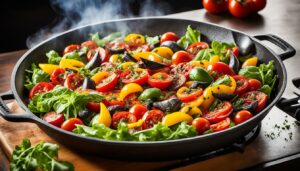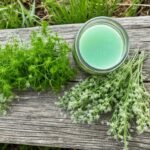Originally posted on November 11, 2023 @ 4:46 am
Have you ever noticed the term “divided” in a recipe and wondered what it meant? This common instruction can be confusing for novice cooks and experienced home chefs alike. However, understanding how to divide ingredients can make or break a dish’s flavor, texture, and overall success.
In this section, we’ll explore the meaning of “divided” in recipes and how to correctly interpret and divide ingredients in your cooking. From basic explanations to step-by-step guides, we’ll provide you with the tools you need to master this essential culinary technique.
Contents
- 1 Dividing Ingredients in Recipes: A Basic Explanation
- 2 The Purpose of Dividing and Separating Ingredients
- 3 Techniques for Dividing Ingredients in Recipes
- 4 Common Examples of Divided Ingredients
- 5 Tips for Accurately Dividing Ingredients
- 6 Step-by-Step Guide: How to Divide Ingredients Correctly
- 7 Overcoming Common Challenges in Dividing Ingredients
- 8 Enhancing Your Culinary Skills Through Divided Ingredients
- 9 Exploring Other Recipe Terminology
- 10 Experimenting with Divided Ingredients: Creativity in the Kitchen
- 11 Conclusion
- 12 FAQ
- 12.1 What does “divided” mean in recipes?
- 12.2 How do I divide ingredients in cooking?
- 12.3 Why do recipes ask for ingredients to be divided and separated?
- 12.4 What are some techniques for dividing ingredients in recipes?
- 12.5 Can you provide some examples of divided ingredients in recipes?
- 12.6 Any tips for accurately dividing ingredients in recipes?
- 12.7 Is there a step-by-step guide for dividing ingredients correctly?
- 12.8 What are some common challenges when dividing ingredients?
- 12.9 How can dividing ingredients enhance my culinary skills?
- 12.10 What other recipe terminology should I be aware of?
- 12.11 Can I experiment with divided ingredients in my own recipes?
Key Takeaways:
- The term “divided” in recipes refers to splitting up an ingredient into separate portions for different stages or purposes in the cooking process.
- Correctly dividing ingredients can enhance the flavors and textures of your dishes, while inaccuracies can result in underseasoned, overseasoned, or unbalanced meals.
- Techniques for dividing ingredients include measuring and portioning, chopping and slicing, and separating liquids and solids.
- Common examples of divided ingredients include eggs, sauces, and spices.
- Accurately dividing ingredients requires a clear understanding of recipe instructions and proper measuring equipment.
Dividing Ingredients in Recipes: A Basic Explanation
Dividing ingredients in recipes is a common instruction that can affect the final outcome of your dish. It involves separating an ingredient into two or more parts and using them at different times during the cooking process.
So, how do you divide ingredients in cooking? There are a few basic techniques you can use:
- Measuring and portioning: This involves measuring the total amount of the ingredient needed for the recipe and dividing it into the necessary parts. For example, if a recipe requires 1 cup of milk divided in half, you would measure out 1 cup and then use half of that amount (½ cup) in one part of the recipe and the remaining half in another part.
- Chopping and separating: This technique involves chopping an ingredient into different sizes or shapes and using them at different times in the recipe. For example, if a recipe calls for both diced and sliced onions, you would chop the onion into two separate piles and use them as directed.
It’s important to follow recipe instructions carefully when dividing ingredients, as it can affect the final texture and flavor of your dish.
Dividing ingredients can seem like a small detail, but it plays a crucial role in creating delicious and perfectly balanced dishes. By following these basic techniques, you can effectively divide ingredients in your cooking and achieve the desired results in your recipes.
The Purpose of Dividing and Separating Ingredients
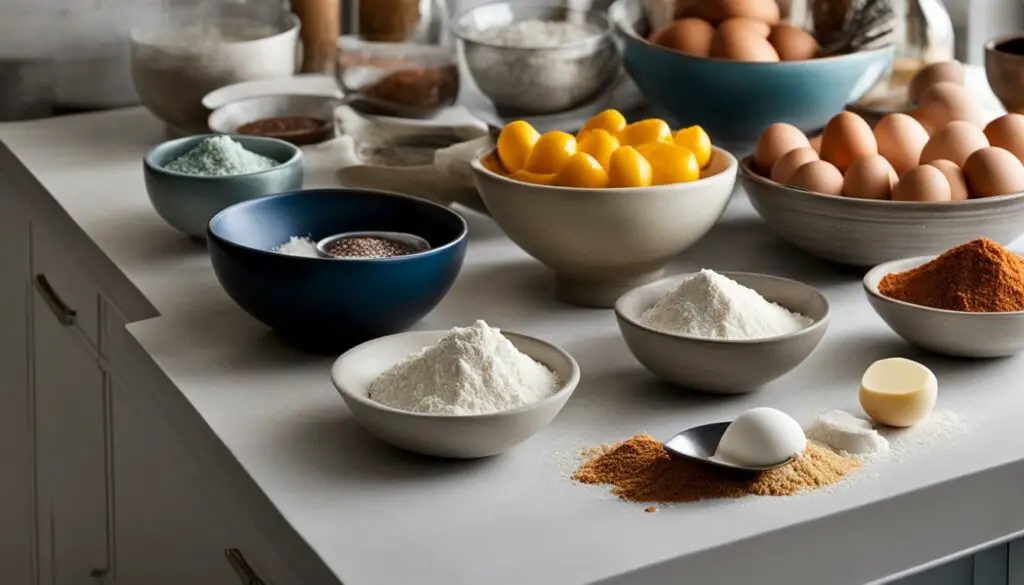
Dividing and separating ingredients is a common instruction found in many recipes, but have you ever wondered why it’s necessary? This technique serves multiple purposes that can greatly enhance the flavors and textures of your dishes.
Why are ingredients divided and separated?
There are several reasons why a recipe may call for ingredients to be divided or separated:
- To control the timing of when ingredients are added to the recipe. For example, if a sauce requires both sugar and vinegar, dividing them up may help control the sweetness and acidity levels.
- To ensure even distribution of ingredients. Dividing ingredients, such as spices or herbs, can help ensure that they are evenly distributed throughout the dish.
- To maintain the texture of certain ingredients. For example, in a recipe that calls for both diced and pureed vegetables, dividing them up can help maintain the desired texture of each.
By understanding these reasons behind dividing and separating ingredients, you can better appreciate the importance of this technique in cooking.
Examples of separated ingredients
The following are common examples of ingredients that may be divided or separated in a recipe:
| Ingredient | Separated Into |
|---|---|
| Eggs | Yolks and whites |
| Sauces | Wet and dry ingredients, such as flavorings and thickeners |
| Spices | Separated into different amounts or added at different times during the cooking process |
Separating ingredients in practice
When separating ingredients in a recipe, it’s important to follow the instructions carefully to ensure the desired outcome. This may involve using separate bowls or containers for each divided ingredient, or carefully measuring out specific amounts for each step.
If a recipe calls for whipped egg whites, for example, it’s important to separate the yolks from the whites carefully, to avoid any trace of yolk which can hinder the whipping process This will ensure that the egg whites can be whipped to their fullest volume to create the desired texture in the recipe.
Overall, understanding the reasons behind dividing and separating ingredients can help you better appreciate the importance of this technique in cooking and ensure that your dishes come out perfectly every time.
Techniques for Dividing Ingredients in Recipes
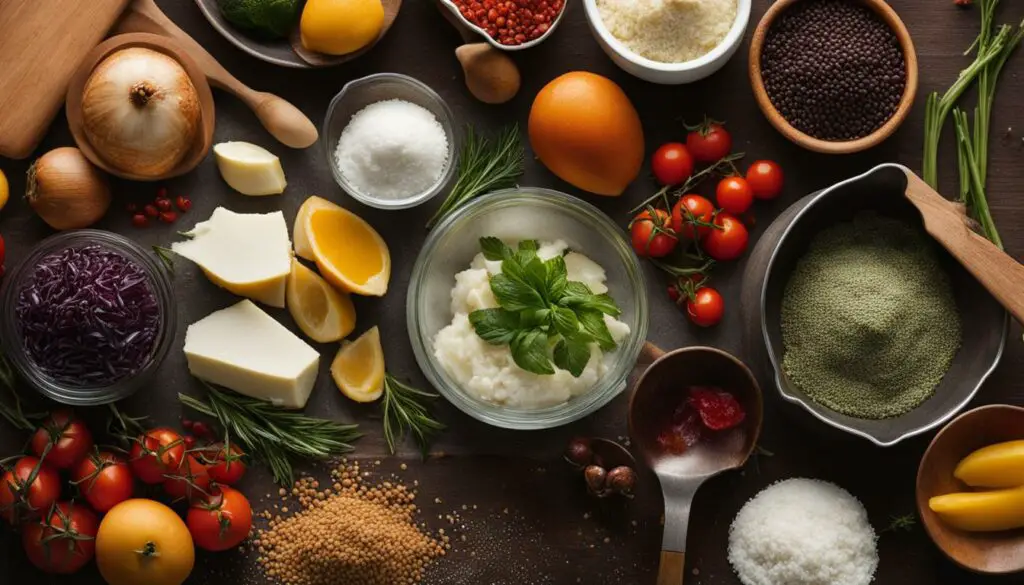
Dividing and separating ingredients in recipes is an essential skill for any cook. Whether you’re following a recipe or creating your own, knowing how to accurately divide ingredients can make all the difference in the final result.
Here are some techniques for dividing ingredients in recipes:
- Measuring: Use measuring cups and spoons to portion out ingredients such as flour, sugar, and liquids.
- Portioning: Divide ingredients like meat or fish into equal portions before cooking to ensure even cooking times.
- Chopping: Chop ingredients like vegetables or herbs into equal-sized pieces for consistent cooking and flavor distribution.
- Separating: Divide ingredients like eggs or sauces into separate parts before adding them to a recipe to prevent over-mixing and achieve the desired texture.
When dividing ingredients in recipes, it’s important to follow the recipe instructions carefully. If a recipe calls for divided ingredients, be sure to read the instructions carefully to understand when and how to divide the ingredient.
Additionally, make sure you have the proper tools on hand to accurately divide and portion out ingredients. Invest in quality measuring cups, spoons, and a kitchen scale to ensure precise measurements.
Example:
For example, a recipe may call for 1 cup of chopped walnuts, divided. This means you should measure out 1 cup of walnuts and then chop them into equal-sized pieces. Once chopped, divide the walnuts in half and use one half for the first part of the recipe and the other half for the second part.
Dividing and separating ingredients in recipes may seem like a small detail, but it can have a big impact on the success of your dish. By mastering the techniques for dividing ingredients, you can achieve consistent and delicious results in your cooking.
Common Examples of Divided Ingredients
Dividing ingredients is a common instruction found in recipes. It involves separating an ingredient into specific amounts for different stages of the cooking process. Here are some common examples of divided ingredients:
- Eggs: Recipes that call for eggs to be divided usually mean separating the yolks from the whites. This is because the yolks are used to thicken sauces or add richness to cakes, while the whites are used to add volume to meringue or souffle.
- Sauces: Dividing sauces means separating the sauce into different amounts to be used in different stages of the recipe. For example, a marinade or glaze may require some of the sauce to be set aside for basting at a later time.
- Spices: Some recipes call for spices to be divided and added at different stages of cooking. For example, a soup may call for some spices to be added at the beginning and others to be added toward the end to enhance the overall flavor.
- Batters: When making a batter, ingredients like flour and milk may be divided and added in alternating amounts to ensure the batter is smooth and consistent.
By dividing ingredients in recipes, you can ensure your dishes have the proper texture, flavor, and consistency. It may seem like a small detail, but it can make a big difference in the final outcome of your cooking.
Next, we’ll provide some helpful tips for accurately dividing ingredients to ensure your recipe turns out just right. But first, let’s take a closer look at the purpose behind dividing and separating ingredients in recipes.
Tips for Accurately Dividing Ingredients

Dividing ingredients in recipes is a common instruction, but it can often be confusing. Here are some tips to help you accurately divide ingredients:
- Read the recipe thoroughly: Before beginning to divide your ingredients, read the recipe carefully to ensure you understand all the instructions. Look out for any specific techniques or tools required to divide the ingredients.
- Use proper measuring tools: To ensure you divide your ingredients accurately, use proper measuring tools such as measuring spoons, cups, or kitchen scales.
- Divide ingredients in stages: If a recipe requires you to divide an ingredient into multiple portions, divide it in stages to ensure accuracy. For example, if a recipe calls for dividing a cup of flour into three portions, divide it into two portions first and then divide one of those portions in half.
- Separate ingredients: If a recipe calls for separating an ingredient such as egg yolks and whites, do so carefully to avoid mixing them together.
- Label portions: Use labels or sticky notes to mark each portion of the divided ingredients to avoid confusion during the cooking process.
By following these tips, you can accurately divide ingredients and ensure the success of your culinary creations.
Step-by-Step Guide: How to Divide Ingredients Correctly
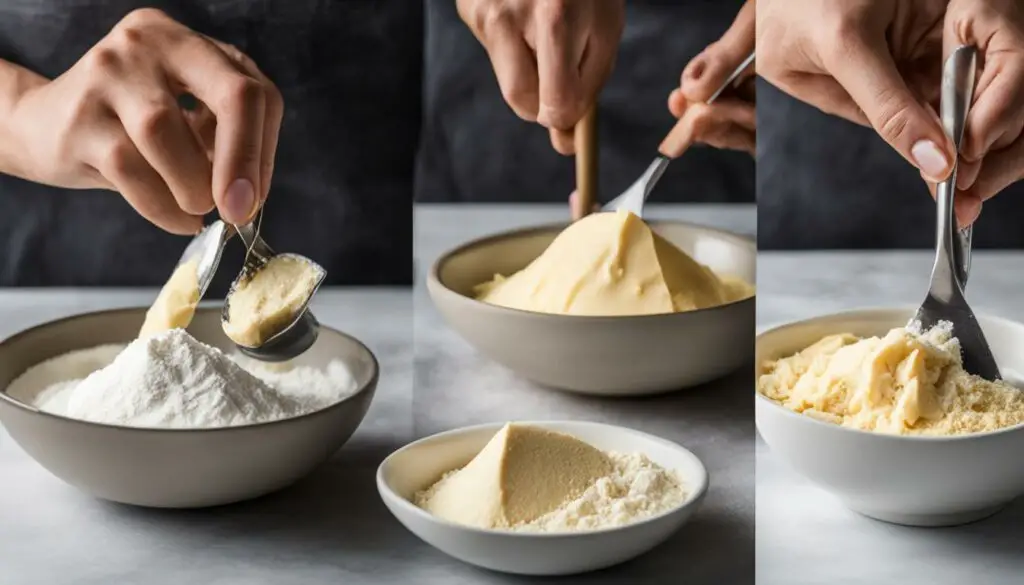
Dividing ingredients may seem like a simple task, but it requires precision and attention to detail to achieve the desired results in your cooking. Follow our step-by-step guide to ensure you accurately divide and separate ingredients in your recipes.
- Read the recipe carefully: Before you begin dividing any ingredients, make sure to read the recipe thoroughly. Pay close attention to any instructions that indicate the amount of the ingredient to be used before and after dividing.
- Prepare your tools: Have all of your necessary tools nearby, including measuring cups and spoons, sharp knives, and cutting boards.
- Divide ingredients properly: Divide the ingredient according to the recipe instructions. Typically, this will involve dividing the ingredient into two or more portions, such as adding half to one part of the recipe and half to another. Use measuring cups or spoons to ensure accurate portions.
- Label divided ingredients: Once you have divided the ingredients, label them accordingly to prevent confusion. For example, if the recipe calls for half of a chopped onion, divide the onion and label one portion “chopped onion for sauce” and the other portion “chopped onion for garnish.”
- Recheck the recipe: After you have divided the ingredients, double-check the recipe instructions to ensure you have properly followed all the steps.
- Combine ingredients at the right time: When adding divided ingredients to the recipe, make sure to add them at the proper time according to the recipe instructions.
Following these steps will ensure your divided ingredients are accurate and enhance the flavors and textures of your dishes, making them stand out from the rest.
Tip: If you’re working with a recipe that calls for a large quantity of an ingredient, such as a gallon of milk, it may not be practical to divide it in half. Instead, you may need to use a kitchen scale to measure out precise portions of the ingredient.
Overcoming Common Challenges in Dividing Ingredients

While dividing ingredients may seem straightforward, certain challenges may arise during the process. Understanding these challenges and how to overcome them can help you create the perfect dish every time.
Challenge 1: Unequal Portion Sizes
| Problem | Solution |
|---|---|
| When dividing ingredients by eyeballing, the portions may be uneven. | Use measuring tools such as measuring cups or spoons to ensure equal portion sizes. |
| When using a knife to divide ingredients, uneven pieces may result. | Use a sharp knife and cut ingredients with precision. Consider using a food processor or chopper for more uniform results. |
By taking these steps, you can ensure your divided ingredients are equal in size and will cook evenly.
Challenge 2: Difficulty Dividing Sticky Ingredients
Ingredients such as honey, molasses, or peanut butter can be challenging to divide due to their sticky nature.
To make this process easier, try these tips:
- Grease your measuring tool with cooking spray or oil before measuring sticky ingredients.
- Warm the ingredient briefly in a microwave or on a stove for a few seconds to soften it, making it easier to measure.
- Use a spoon or spatula to scrape the ingredients out of the measuring tool.
Challenge 3: Dividing Small Quantities of Ingredients
Dividing small quantities of ingredients can also pose a challenge, particularly when using measuring spoons.
To overcome this challenge, try using a digital scale for more precise measurements. Simply place your measuring tool on the scale, reset it to zero, and add the ingredient until you reach the desired weight.
By taking these steps, you can overcome common challenges in dividing ingredients and achieve consistent and delicious results in your cooking.
Enhancing Your Culinary Skills Through Divided Ingredients
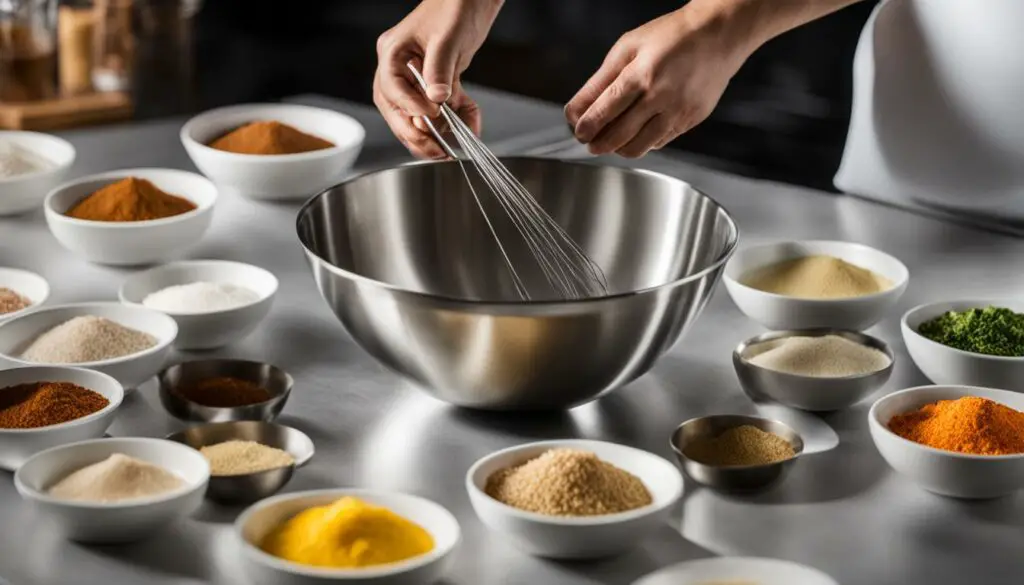
Understanding and effectively using divided ingredients is a key technique that can enhance your culinary skills and take your cooking to the next level. By carefully portioning and separating ingredients, you can achieve a depth of flavor and complexity that truly impresses. Here are some tips for using divided ingredients to elevate your dishes:
- Experiment with different techniques: Try out different ways to divide and separate ingredients, such as measuring by weight or volume, using a food scale, or cutting ingredients into specific shapes and sizes. This can add variety to your cooking and improve your accuracy.
- Pay attention to recipe instructions: Always read recipe instructions carefully to ensure you understand when and how to divide ingredients. This will help you avoid mistakes and ensure consistent results.
- Use proper measuring tools: When dividing ingredients, it’s important to be precise. Use measuring cups, measuring spoons, and a kitchen scale to ensure accurate portions.
By following these tips and mastering the art of divided ingredients, you can create dishes that are not only delicious but also visually appealing. Take a look at this beautiful dish that uses perfectly divided and arranged ingredients:
Dividing ingredients can be challenging at first, but with practice and patience, you’ll soon master this technique and be able to create amazing dishes that showcase your culinary skills.
Exploring Other Recipe Terminology

Understanding recipe terminology is crucial to creating a successful dish. Here are a few common terms you may encounter in recipes:
- Sauté: This term refers to cooking over high heat in a small amount of oil or butter, typically in a sauté pan.
- Simmer: To simmer is to cook over low heat in liquid that is just below boiling point. This technique is commonly used for soups, stews, and sauces.
- Braise: Braising involves browning meat before cooking it in a small amount of liquid, covered, over low heat. This method is ideal for tougher cuts of meat.
- Blanch: Blanching involves briefly boiling vegetables in salted water before quickly cooling them in ice water to stop the cooking process. This technique is commonly used to prepare vegetables for salads or for freezing.
Understanding Divided Ingredients in Recipes
As we discussed earlier, “divided” in recipes refers to splitting up an ingredient and using it at different times in the recipe. This technique is common for ingredients that require different cooking times or preparation methods to achieve the desired flavors and textures.
When dividing ingredients, it’s important to follow the recipe instructions carefully and ensure that you are using the correct amounts of each portion. Proper measurement techniques and precision are key to successfully dividing ingredients in your cooking.
“Understanding recipe terminology is the first step to creating delicious dishes.”
Experimenting with Divided Ingredients: Creativity in the Kitchen
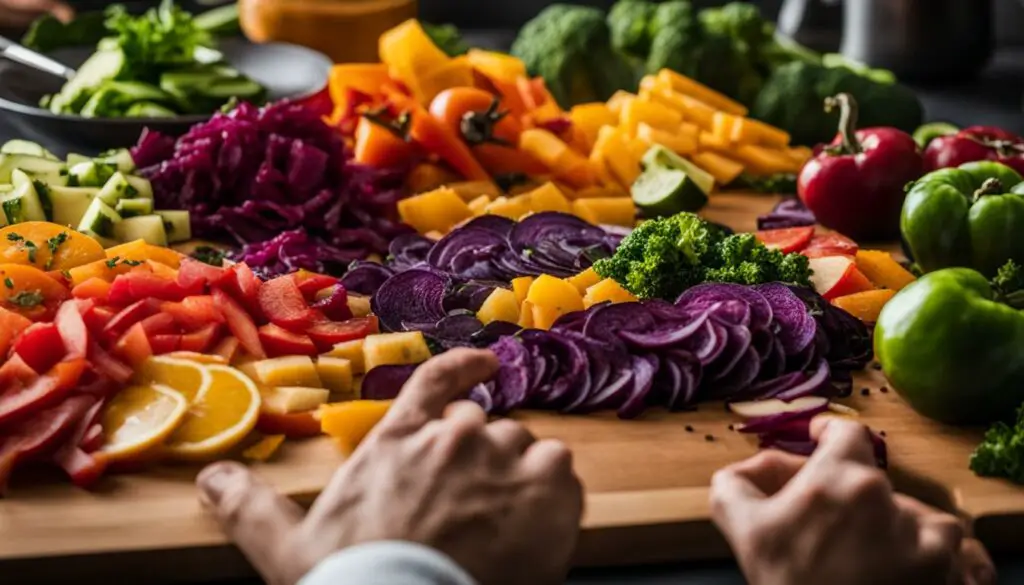
Now that you have a solid understanding of how to divide ingredients in recipes, it’s time to get creative in the kitchen! Experimenting with divided ingredients can lead to exciting new flavors and textures in your dishes.
One great way to experiment with divided ingredients is to try different methods of dividing and separating. For example, instead of simply adding all of your spices at once, try dividing them into different stages of cooking to see how it affects the overall flavor.
Another fun idea is to mix and match divided ingredients from different recipes to create your own unique dishes. Don’t be afraid to think outside the box and try new combinations!
If you’re feeling adventurous, you can also experiment with dividing ingredients in unconventional ways. For example, instead of dividing eggs by yolks and whites, try dividing them in different ratios to see how it affects the texture of your dish.
Remember, experimenting with divided ingredients is all about having fun and exploring your creativity in the kitchen. Don’t be afraid to try new things and make mistakes – after all, that’s how some of the best culinary discoveries are made!
Tips for Experimenting with Divided Ingredients:
- Start small – try dividing just one or two ingredients at a time
- Keep track of your methods and measurements so you can replicate successful experiments
- Take risks and try new combinations, but also be willing to acknowledge when things don’t work out
- Have fun and enjoy the process of exploring your creativity in the kitchen
Conclusion
In conclusion, understanding the term “divided” in recipes is crucial to achieving the desired flavors and textures in your dishes. By accurately dividing and separating ingredients, you can enhance your culinary skills and impress family and friends with your creations. Remember to use proper measuring tools, follow recipe instructions carefully, and experiment with the different techniques discussed in this guide.
Now that you are familiar with the meaning of the term “divided” in recipes, you can confidently navigate through recipe instructions and produce delicious meals in your kitchen. Keep in mind that mastering the art of dividing ingredients takes practice, but with time and patience, you’ll become a pro.
Expand Your Culinary Knowledge
While this guide has focused on the meaning of “divided” in recipes, there are many other recipe terms to explore that can expand your culinary knowledge. From “fold” to “whisk,” familiarizing yourself with these terms can help you improve your cooking skills and create even more delicious dishes.
Thank you for reading and happy cooking!
FAQ
What does “divided” mean in recipes?
When a recipe instructs you to divide an ingredient, it means that you should separate it into different portions to be used at different times or in different ways throughout the cooking process.
How do I divide ingredients in cooking?
To divide ingredients in cooking, follow the specific instructions provided in the recipe. This may involve measuring and portioning the ingredient into separate containers or dividing it into different stages of the cooking process.
Why do recipes ask for ingredients to be divided and separated?
Dividing and separating ingredients in recipes serves several purposes. It can help to layer flavors, control cooking times, enhance textures, and create a more balanced overall dish.
What are some techniques for dividing ingredients in recipes?
Techniques for dividing ingredients vary depending on the specific recipe, but common methods include measuring and portioning, chopping and dicing, and separating liquids from solids.
Can you provide some examples of divided ingredients in recipes?
Examples of divided ingredients in recipes include separating eggs into yolks and whites, dividing sauces into different stages of cooking, and splitting spices to be added at different times for maximum flavor.
Any tips for accurately dividing ingredients in recipes?
To accurately divide ingredients in recipes, carefully read and understand the instructions. Use proper measuring tools, follow portioning guidelines, and ensure you have the necessary containers or utensils for separating ingredients.
Is there a step-by-step guide for dividing ingredients correctly?
Yes! We have provided a detailed step-by-step guide on how to divide ingredients correctly in our separate guide. Follow the instructions to ensure accurate division and separation for the best culinary outcomes.
What are some common challenges when dividing ingredients?
Common challenges when dividing ingredients include misinterpreting instructions, inaccurate measuring, and improper portioning. We provide solutions and tips for overcoming these challenges in our separate guide.
How can dividing ingredients enhance my culinary skills?
Understanding and effectively using divided ingredients can enhance your culinary skills by allowing you to create more complex and layered flavors, experiment with different cooking techniques, and improve your overall presentation and plating skills.
What other recipe terminology should I be aware of?
While our main focus is on understanding “divided” in recipes, it’s always beneficial to broaden your culinary knowledge. We briefly touch upon other common recipe terminology in our separate guide to enhance your overall cooking skills.
Can I experiment with divided ingredients in my own recipes?
Absolutely! We encourage you to explore and experiment with dividing ingredients in your own recipes. This can lead to unique flavor combinations and unleash your creativity in the kitchen. Have fun and enjoy the process!




